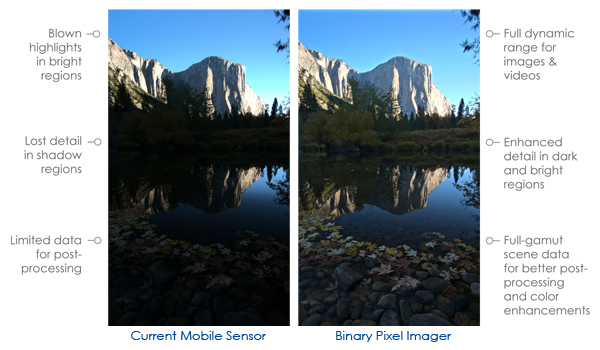The ultimate binary pixel sensor may be a step closer to reality. Rambus, a major intellectual property company, announced what may eventually be licensed to sensor and/or camera makers: binary pixels.
Binary pixel technology produces professional quality images by capturing details in the full spectrum of a scene — from brightest highlights to the darkest shadows. The sensor is optimized at the pixel level to deliver DSLR-level dynamic range from mobile and consumer cameras.
The ultimate binary pixel sensor is, of course, the Quanta Image Sensor (QIS) where each bit is a photoelectron. According to Dr. Eric Fossum, inventor of the CMOS active pixel sensor and a driving force behind QIS, the Rambus simulations show that even before then, binary pixels are pretty interesting when the sampling rate is high enough.

How are binary pixels different from sensors we use today? Rambus:
While the resolution and frame rates supported by mainstream mobile cameras have continued to improve, enhancements in image quality are lagging. High contrast scenes typical in daily life, such as bright landscapes, sunset portraits and scenes with both sunlight and shadow, are difficult to capture with today’s small sensors — the range of bright and dark details in these scenes simply exceeds the limited dynamic range of mainstream CMOS imagers.
The Rambus binary pixel technology mimics the brilliance of human visual processing by sensing photons using discrete thresholds similar to the rods and cones of the human eye. This “binary operation” creates dramatically better videos and photos from mobile and consumer devices that include the full gamut of details in dark and bright intensities.
The complete scene data enables more creative post-processing and color enhancement capabilities resulting in more “keeper” images and videos that showcase life as it was meant to be seen.
Operating in a single exposure period at high speed frame rates, binary pixel imagers capture HDR images in real-time with on-the-fly processing, enabling handheld photo and video capabilities with zero post-capture processing.
Temporal oversampling technology improves the sensor’s signal-to-noise performance in low light conditions to reduce noise and graininess for better indoor and night-time photography.
Patented Rambus binary pixel imagers, we’re promised, fit in a comparable form factor, cost and power envelope as today’s CMOS imagers. They are designed to be integrated in existing system-on-chip (SoC) architectures and can be manufactured using current CMOS image sensor technology.
Now must imagine a full-frame binary pixel imager…


